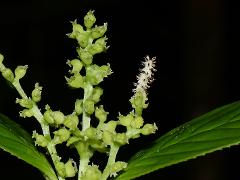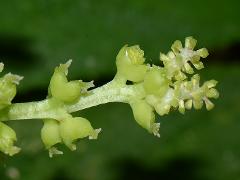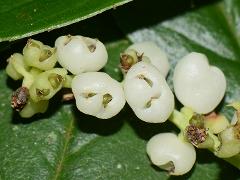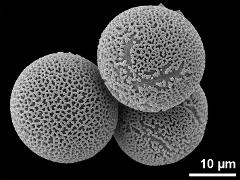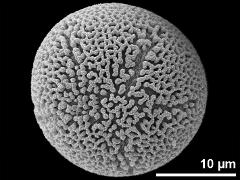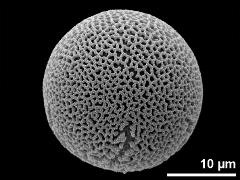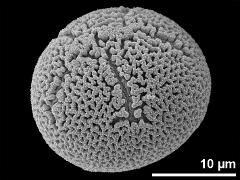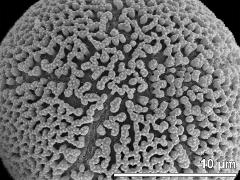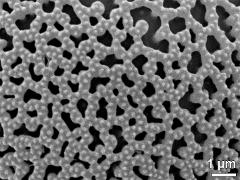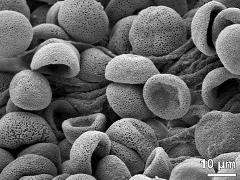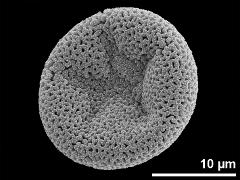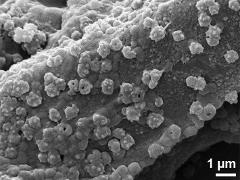Hedyosmum scaberrimum
Taxonomy: Angiospermae, Chloranthales, Chloranthaceae, Hedyosmum
Published: 2016-03-12
Pollen Description
Shape, Size and Aperture
pollen unit: monad, dispersal unit and peculiarities: monad, size (pollen unit): small (10-25 µm), size of hydrated pollen (LM): -, shortest polar axis in equatorial view (LM): -, longest polar axis in equatorial view (LM): -, shortest diameter in equatorial or polar view (LM): -, longest diameter in equatorial or polar view (LM): -, pollen class: sulcate, polarity: heteropolar, P/E-ratio: -, shape: spheroidal, outline in polar view: circular, dominant orientation (LM): -, P/E-ratio (dry pollen): -, shape (dry pollen): cup-shaped, outline in polar view (dry pollen): circular, infoldings (dry pollen): aperture(s) sunken, aperture number: 1, aperture type: sulcus, aperture condition: sulcate, polychotomosulcate, aperture peculiarities: polychotomosulcus
Ornamentation and Structure
LM ornamentation LM: -, nexine: -, sexine: -, SEM ornamentation SEM: reticulate, microechinate, suprasculpture SEM: -, TEM tectum: -, infratectum: -, foot layer: -, endexine: -, intine: -, wall peculiarities: -, supratectal element: -
Miscellaneous
pollen coatings: -, reserves in cytoplasm: -, cell number: -, Ubisch bodies: present
Annotations: sulcus mostly 5-radiate
Author(s) of diagnosis: Halbritter, Heidemarie
Pictures
Picture legend
- inflorescence(s), photographer: Berger, A.
- flower(s), photographer: Berger, A.
- flower(s), photographer: Berger, A.
- hydrated pollen - dry, rehydrated (water) & critical point dried & sputter coated with gold, photographer: Halbritter, H.
- polar distal view - dry, rehydrated (water) & critical point dried & sputter coated with gold, photographer: Halbritter, H.
- polar proximal view - dry, rehydrated (water) & critical point dried & sputter coated with gold, photographer: Halbritter, H.
- oblique equatorial view - dry, rehydrated (water) & critical point dried & sputter coated with gold, photographer: Halbritter, H.
- aperture detail - dry, rehydrated (water) & critical point dried & sputter coated with gold, photographer: Halbritter, H.
- exine surface - dry, rehydrated (water) & critical point dried & sputter coated with gold, photographer: Halbritter, H.
- dry pollen - dry, sputter coated with gold, photographer: Halbritter, H.
- dry pollen, polar distal view - dry, sputter coated with gold, photographer: Halbritter, H.
- Ubisch bodies on locule wall - dry, rehydrated (water) & critical point dried & sputter coated with gold, photographer: Halbritter, H.
Literature
- (1998) Preparing living pollen material for scanning electron microscopy using 2,2-dimethoxypropane (DMP) and criticalpoint drying. Biotechnic Histochem 73: 137–143
Copyright and Citation
Cite this publication as:
Halbritter H., Berger A. 2016. Hedyosmum scaberrimum. In: PalDat - A palynological database. https://www.paldat.org/pub/Hedyosmum_scaberrimum/300628;jsessionid=056A2C7E2B6263019CFFE21E66A5D953; accessed 2024-04-30

